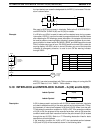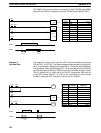
155
the input device) can cause the designated bit of KEEP(11) to be reset. This situ-
ation is shown below.
A
Input Unit
A
NEVER
S
R
KEEP(11)
B
Bits used in KEEP are not reset in interlocks. Refer to the 5-10 INTERLOCK –
and INTERLOCK CLEAR IL(02) and ILC(03) for details.
Example If a HR bit or an AR bit is used, bit status will be retained even during a power
interruption. KEEP(11) can thus be used to program bits that will maintain status
after restarting the PC following a power interruption. An example of this that can
be used to produce a warning display following a system shutdown for an emer-
gency situation is shown below. Bits 00002, 00003, and 00004 would be turned
ON to indicate some type of error. Bit 00005 would be turned ON to reset the
warning display. HR 0000, which is turned ON when any one of the three bits
indicates an emergency situation, is used to turn ON the warning indicator
through 00500.
HR 0000
00500
00002
00003
00004
00005
Reset input
Indicates
emergency
situation
Activates
warning
display
S
R
KEEP(11)
HR 0000
Address Instruction Operands
00000 LD 00002
00001 OR 00003
00002 OR 00004
00003 LD 00005
00004 KEEP(11) HR 0000
00005 LD HR 0000
00006 OUT 00500
KEEP(11) can also be combined with TIM to produce delays in turning bits ON
and OFF. Refer to 5-14-1 TIMER – TIM for details.
5-10 INTERLOCK and INTERLOCK CLEAR – IL(02) and ILC(03)
Ladder Symbol
IL(02)
Ladder Symbol
ILC(03)
Description IL(02) is always used in conjunction with ILC(03) to create interlocks. Interlocks
are used to enable branching in the same way as can be achieved with TR bits,
but treatment of instructions between IL(02) and ILC(03) differs from that with
TR bits when the execution condition for IL(02) is OFF. If the execution condition
of IL(02) is ON, the program will be executed as written, with an ON execution
condition used to start each instruction line from the point where IL(02) is located
through the next ILC(03). Refer to 4-7-7 Branching Instruction Lines for basic
descriptions of both methods.
If the execution condition for IL(02) is OFF, the interlocked section between
IL(02) and ILC(03) will be treated as shown in the following table:
INTERLOCK and INTERLOCK CLEAR – IL(02) and ILC(03) Section 5-10


















